I fumbled with my binoculars to look at the buck as he ran. I could see that he was hit hard. He ran over the dam for 80 yards, stopped, and lay down. At this point I turned my attention to the doe. I had seen her run over the dam as well, but I didn’t see her run down the draw. I felt certain she would be piled up just out of sight.
As I glassed I saw a flash of white in the draw. It took me a moment to realize I was looking at a coyote coming up the draw toward the water hole. As it reached the buck’s trail, it turned and followed. By now I could see that the buck had his head lying on the ground. I knew I had to get out of the blind and run the coyote off before he made a meal of my buck.
As the coyote approached the buck from behind and began sniffing the hindquarters, the buck jumped up and ran over the hill with the coyote in pursuit. Inside I was screaming, “This is not really happening!” I cursed the coyote for messing with a rare opportunity to take two antelope in a matter of moments with Isabelle, my daughter, beside me.
I was tired after nearly a week of dawn to dusk antelope hunting. The days are long in August. We had been getting in our blind before first light and staying until sunset. When I woke five-year-old Isabelle that morning, she jumped out of bed dressed and was ready to go before I had coffee made. Oh, the optimism of youth. “Today is the day,” she said as we hopped in the truck for our bumpy ride across the prairie to our water hole.
If you have ever hunted in a blind over water for antelope, you know that hot weather means thirsty antelope. This year had been hotter than average, and we were experiencing more drought here in Montana. Hot weather is nice until you are sitting in an enclosed blind with no breeze and a temperature over 100 degrees.
 In addition to being hot, keeping an active five year-old occupied and quiet in a small confined space twelve hours a day proved to be a real challenge. She played with toys and took naps. We colored pages together and whispered stories back and forth. The ranch we were hunting raises horses. Like clockwork each day, groups of horses would come in for a drink and entertain us for a few minutes, only to disappear into the endless prairie not to be seen until the next day.
In addition to being hot, keeping an active five year-old occupied and quiet in a small confined space twelve hours a day proved to be a real challenge. She played with toys and took naps. We colored pages together and whispered stories back and forth. The ranch we were hunting raises horses. Like clockwork each day, groups of horses would come in for a drink and entertain us for a few minutes, only to disappear into the endless prairie not to be seen until the next day.
We also had plenty of snacks and water. Fortunately, we could see the surrounding area fairly well from within the blind, enabling us to get ready and be quiet when we saw antelope approaching.
That day, I’d looked up from the book I was reading to see an antelope peering over the ridge in front of the blind, a young 10-inch buck we had seen every day for the past three. He was with a bachelor group, which included a couple of smaller bucks and a dandy 14-incher I hoped to put my tag on. Just the day before this group had come to the pond and watered 20 yards from the blind, but a group of horses were watering at the same time, and a clear shot never materialized.
Today the group of bucks appeared to be going to the other side of the pond, way out of my longbow range. That’s the problem with this particular pond—it’s just too big, and antelope often water out of range. Like most of the ponds in these parts, dirt has been pushed up around a low spot in the prairie to catch the spring run off, creating the lifeblood allowing animals to survive here.
My hunting partners and I have tried various things to encourage antelope to water close to our blinds. We have put up our blinds well before the season for the antelope to get used to, used decoys, and put other blinds at likely watering spots around the pond. None of these things worked on this particular pond because it is just too big. We would have to be patient.
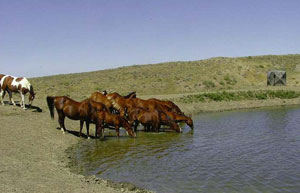 The first buck hesitated and then walked to the waters edge to drink, followed by the two smaller bucks and the one I really wanted. I reached down and woke Isabelle from her mid-morning nap to show her the bucks. She stood, and we admired the antelope as the bucks gulped down water. As the bucks began to finish drinking I noticed they were looking at something behind us. I figured a group of horses were on the way in, when a doe antelope walked right by the blind and down to the water. She put her head down and began drinking immediately.
The first buck hesitated and then walked to the waters edge to drink, followed by the two smaller bucks and the one I really wanted. I reached down and woke Isabelle from her mid-morning nap to show her the bucks. She stood, and we admired the antelope as the bucks gulped down water. As the bucks began to finish drinking I noticed they were looking at something behind us. I figured a group of horses were on the way in, when a doe antelope walked right by the blind and down to the water. She put her head down and began drinking immediately.
Antelope are hard to predict when they drink. Some will take their time, while others will grab a quick drink and run away. I had a doe tag in my pocket, and, figuring the bucks were not going to cooperate today anyway, I decided to try to fill it. When I whispered my intentions to Isabelle, she gave me two thumbs up and slipped behind me to look over my shoulder as I drew my bow.
Antelope have a natural aiming point where the white of their side meets the brown/orange just behind their shoulder. With the doe standing broadside, I took a moment to make sure I was focused on this spot and then felt my fingers slip off the string. The
chartreuse feathers of my cedar arrow disappeared six inches behind the spot I was focused on. The doe sprinted 15 yards and stopped, but I could tell by the way she was standing she would not last long.
I turned to look at Isabelle and saw her motioning me to look back out the window. The group of bucks was running across the dam up to the doe. The young bucks reminded me of a group of jake turkeys that has just found the only hen in the woods. The large buck
hung back like an experienced gentleman, but he had moved into my comfortable shooting range.
I reached for my longbow, which was now tangled in my coat and backpack on the floor of the blind, fighting the urge to hurry and praying the buck would stay in range long enough to offer a shot. The buck was quartering away, and the arrow hit him at the last rib, angling forward. I saw him run over the dam and head down the draw away from the water hole.
Then the coyote chased the buck over the hill and out of sight, as described earlier. The terrain to the west in the direction the buck disappeared is a broken jumble of canyons and sage. Finding an antelope there would be difficult, and I felt uncertain about our chances of seeing him again.
Unzipping the blind and pushing my bow ahead, I climbed out. Isabelle was right behind me as we ran across the dam and up the hill. We crested the hill figuring both the antelope and the coyote would be out of sight, but I was surprised to see the buck coming toward us on the same trail we were on, with the coyote in hot pursuit.
Taking an arrow out of my bow quiver, I knelt down, motioned for Isabelle to do the same, and waited. The antelope saw me as he crested the hill and turned to the right. He was at the edge of my effective shooting range and showed no sign of slowing down. My instincts took over, and I remember shooting in one fluid motion. The arrow took the antelope in almost the same place as the first one. This time, he stumbled and went down for good.
The coyote took one look at us, swapped ends, and bolted out of sight. I turned to look at Isabelle kneeling behind me. She said, “Wow! We got him, Dad!”
Speechless, I sat down to analyze what had just happened.
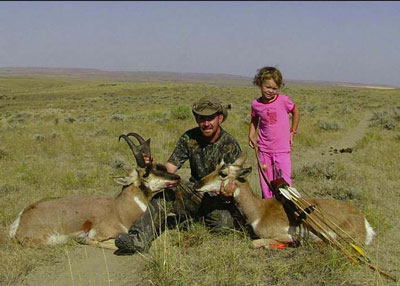 Isabelle began talking excitedly. I looked over at her, proud to share this moment. The week of hard hunting was worth every moment. The intense heat of the blind, the letdown from the buck being in range the day before without offering a shot, the early mornings and late nights—these all formed part of the memory.
Isabelle began talking excitedly. I looked over at her, proud to share this moment. The week of hard hunting was worth every moment. The intense heat of the blind, the letdown from the buck being in range the day before without offering a shot, the early mornings and late nights—these all formed part of the memory.
We went to the buck, knelt down, examined his horns and the beauty of his hide, attached my tag, and enjoyed a quick anatomy lesson. Caught up in the moment, I suddenly remembered the doe. Turning around, we ran down the hill together and there she was, right over the dam. She was a mature doe and would be excellent eating, as would the buck. After tagging her, we walked back to the blind to grab my pack and camera.
Isabelle wanted me to drag the doe to the buck so we could take pictures of both of them together. We managed to drag the doe up the hill to the buck. Positioning them together, I set the timer on the camera and took pictures. Isabelle laughed and said the antelope looked as if they were kissing. To this day she asks me to tell her the story of the time we shot two antelope, a coyote chased one of them, and they wound up kissing.
A taxidermist friend mounted the buck for me, and it now hangs in my classroom. Each time I look at it, I’m reminded of priceless memories of a little girl, a coyote, and two antelope.
Equipment Notes: For his antelope hunt Robb used a homemade longbow, cedar arrows tipped with Snuffer broadheads.



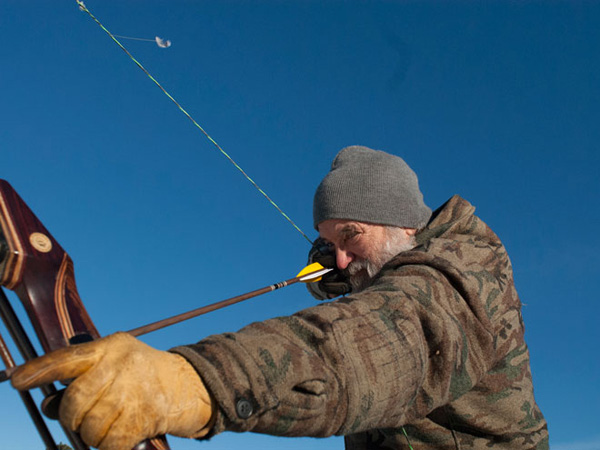
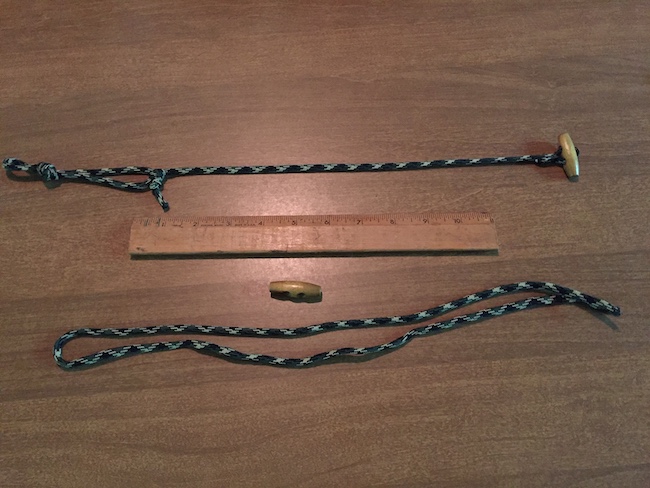
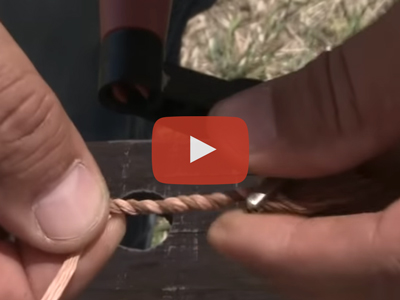
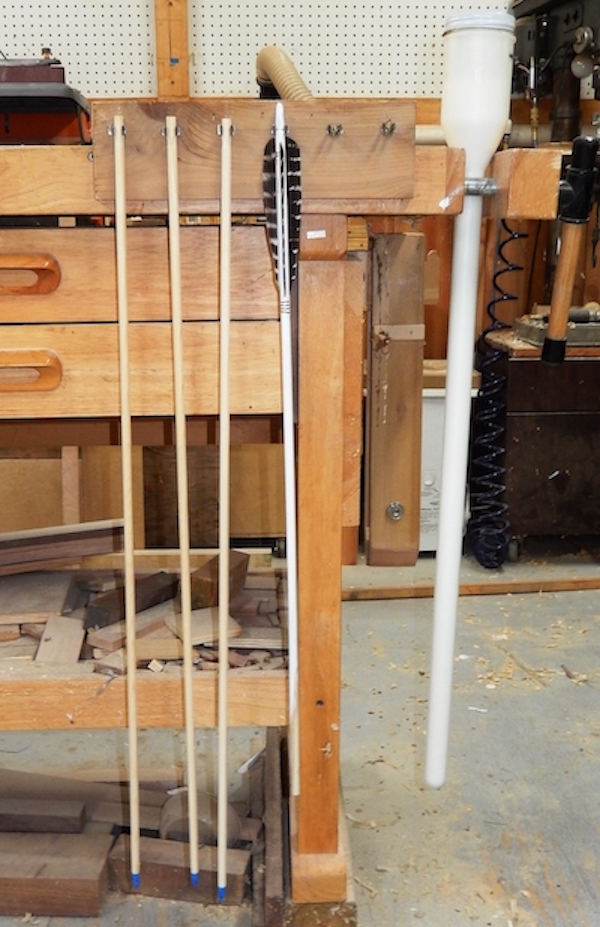
Leave A Comment